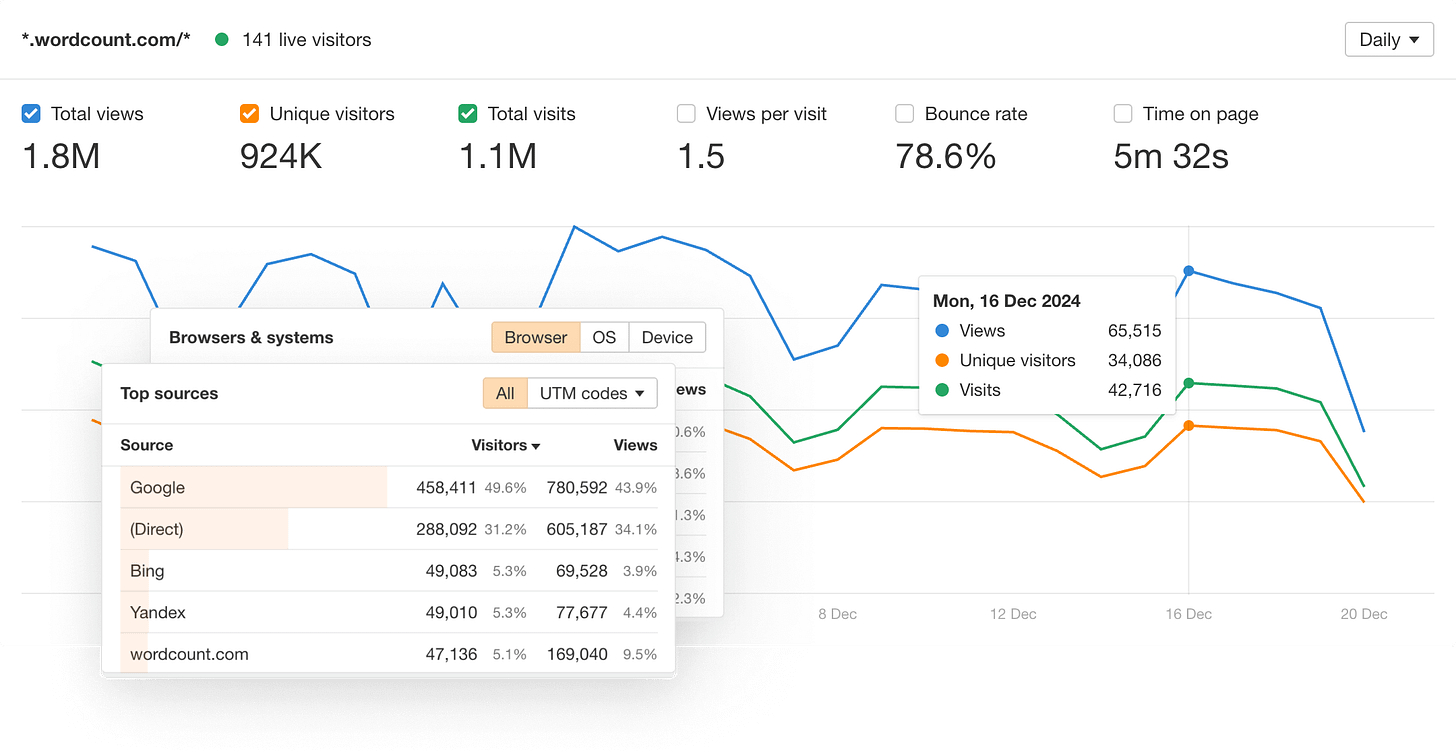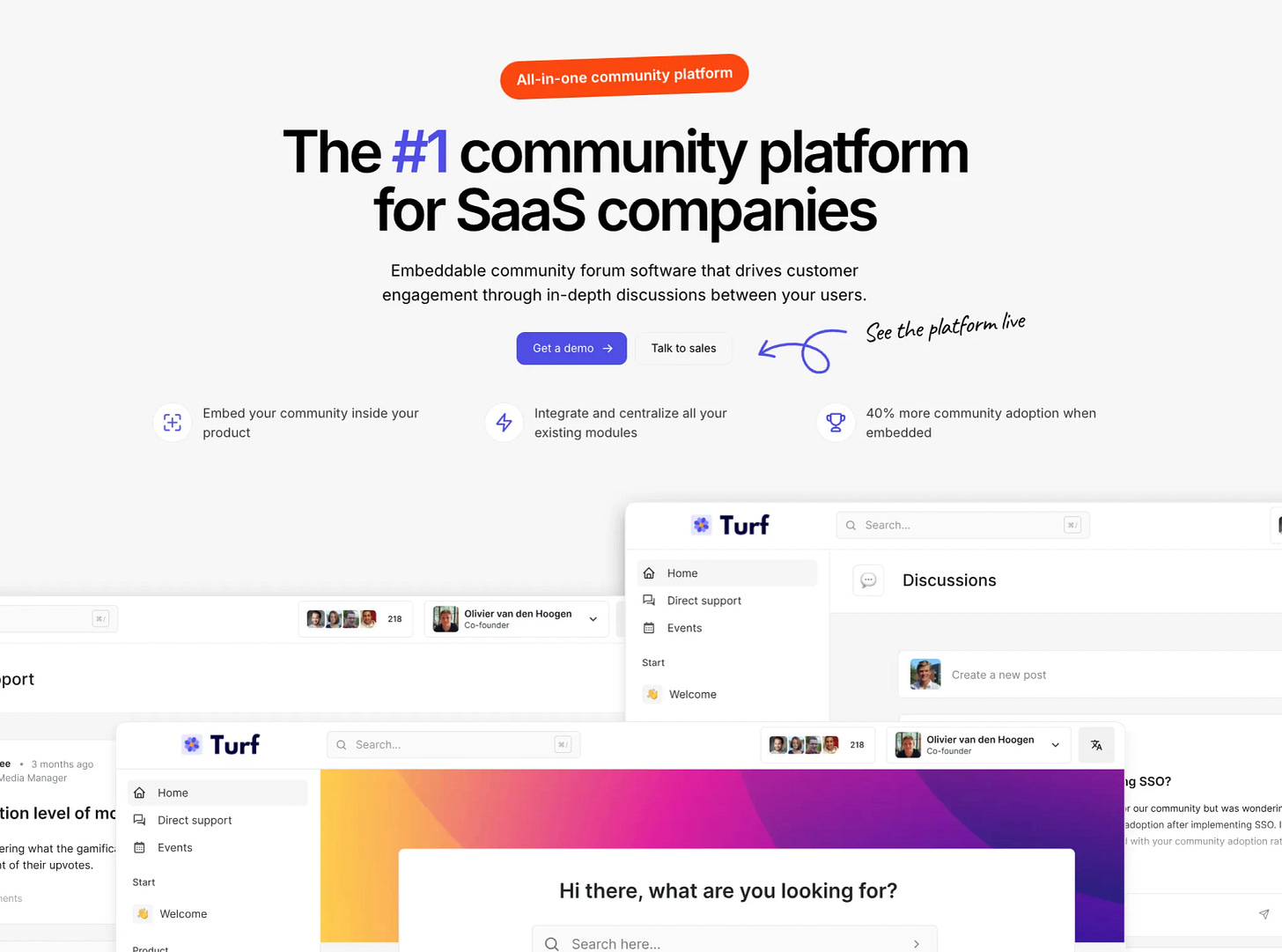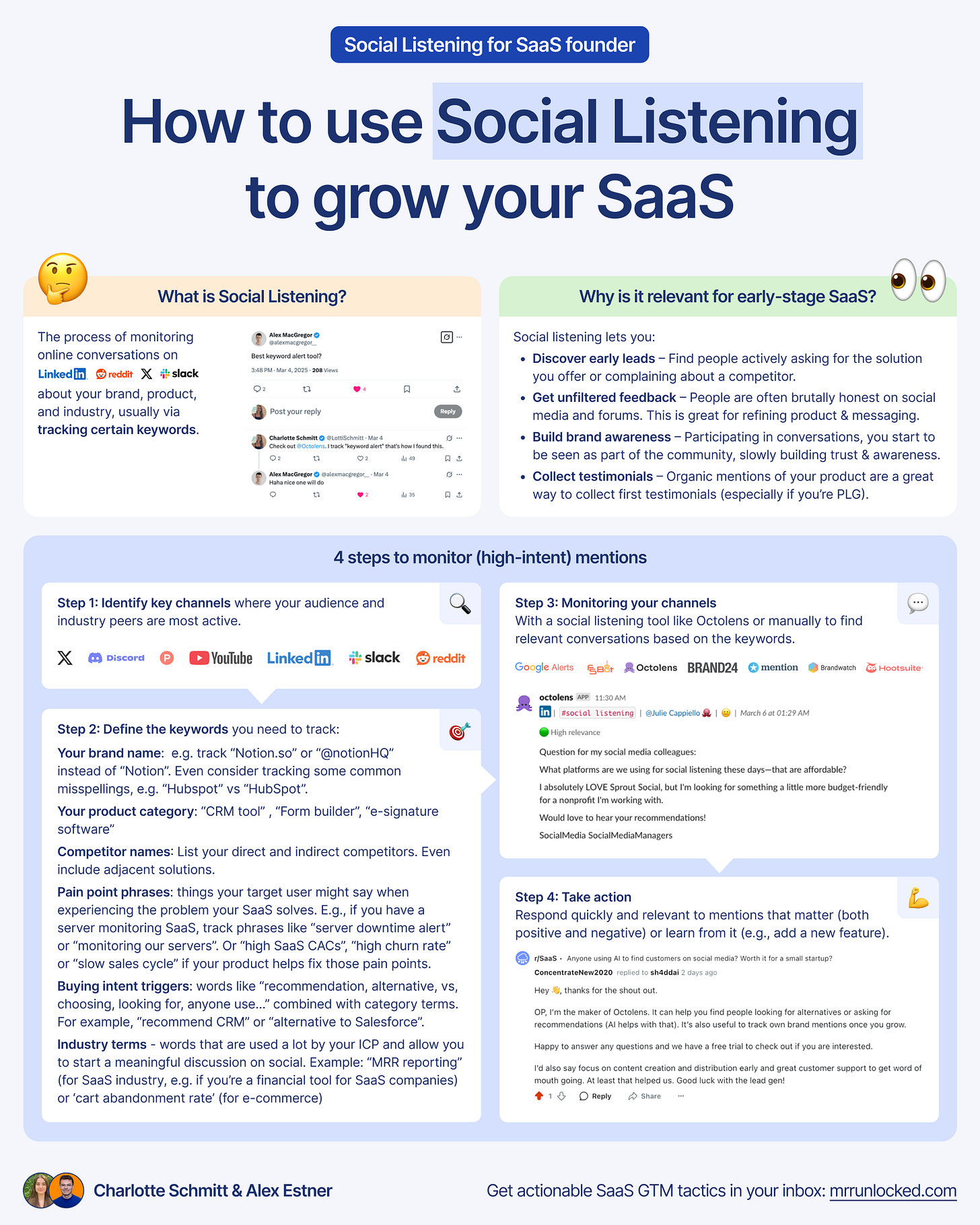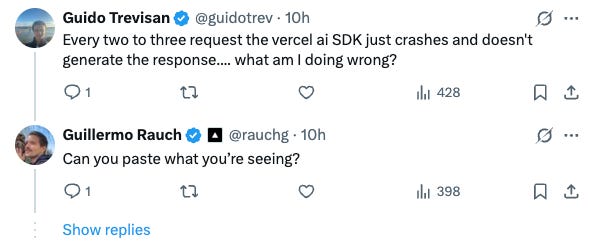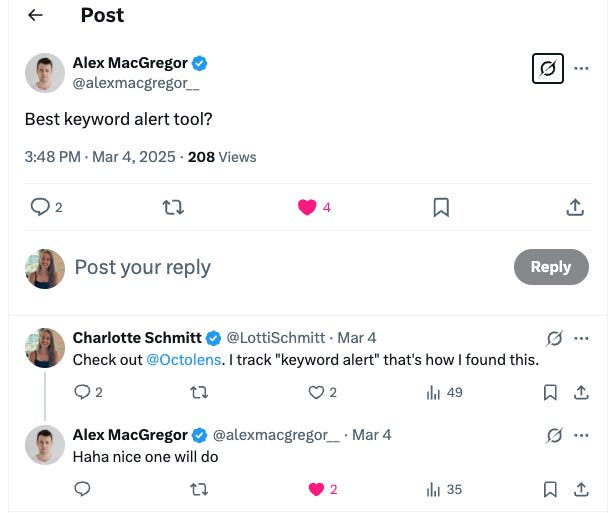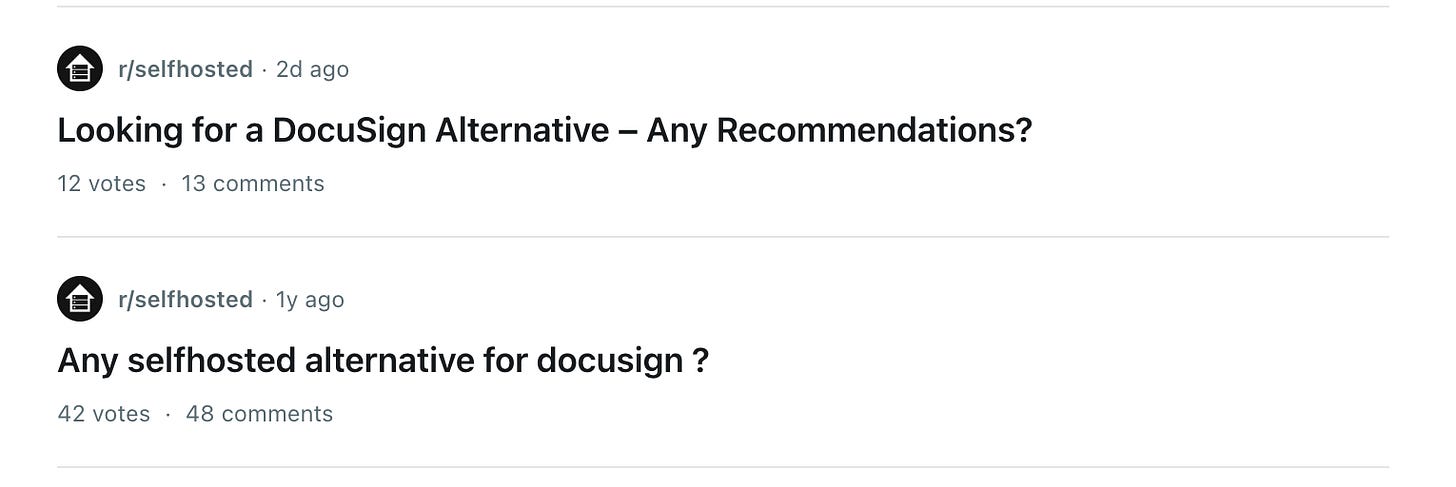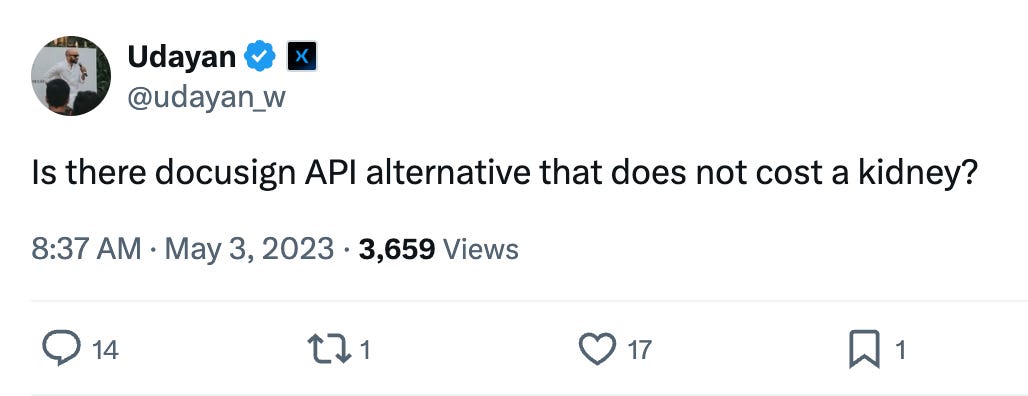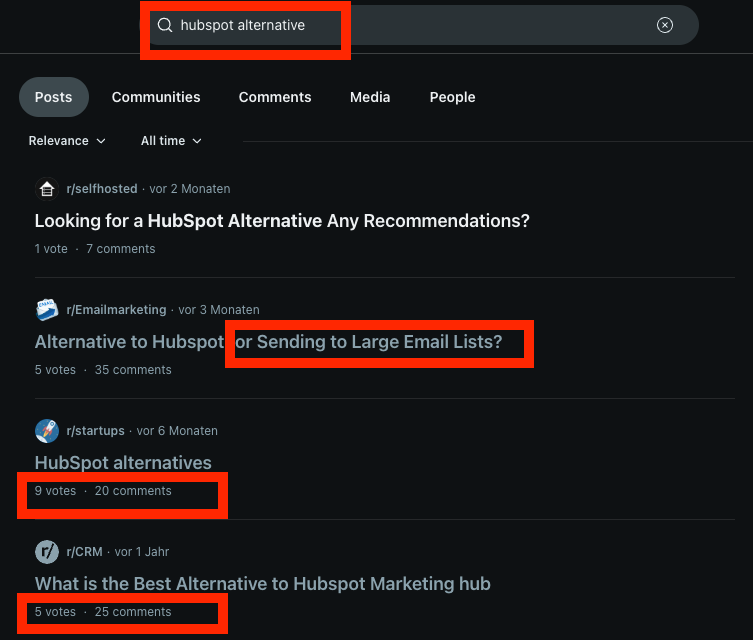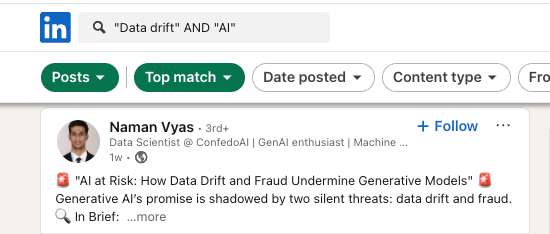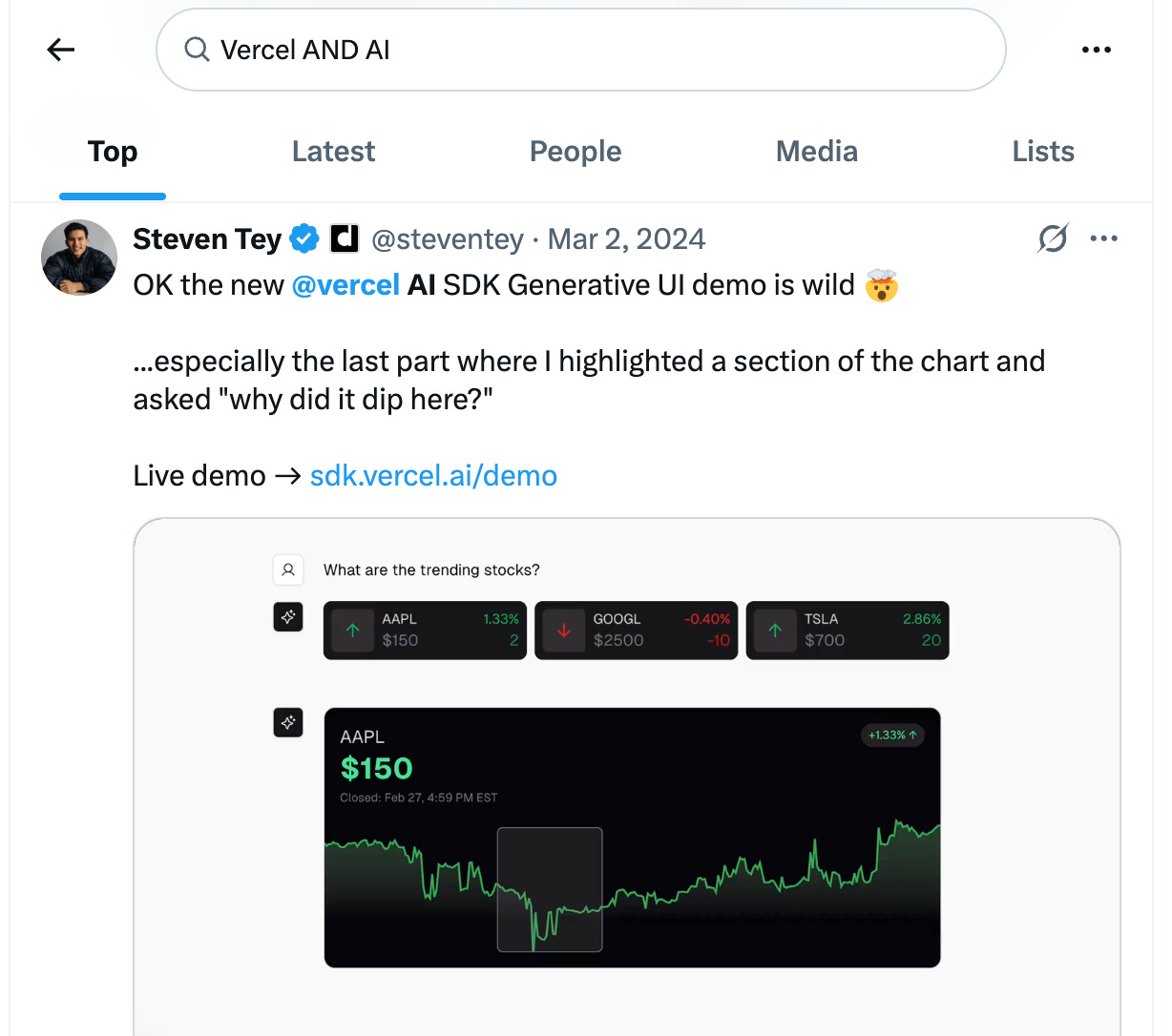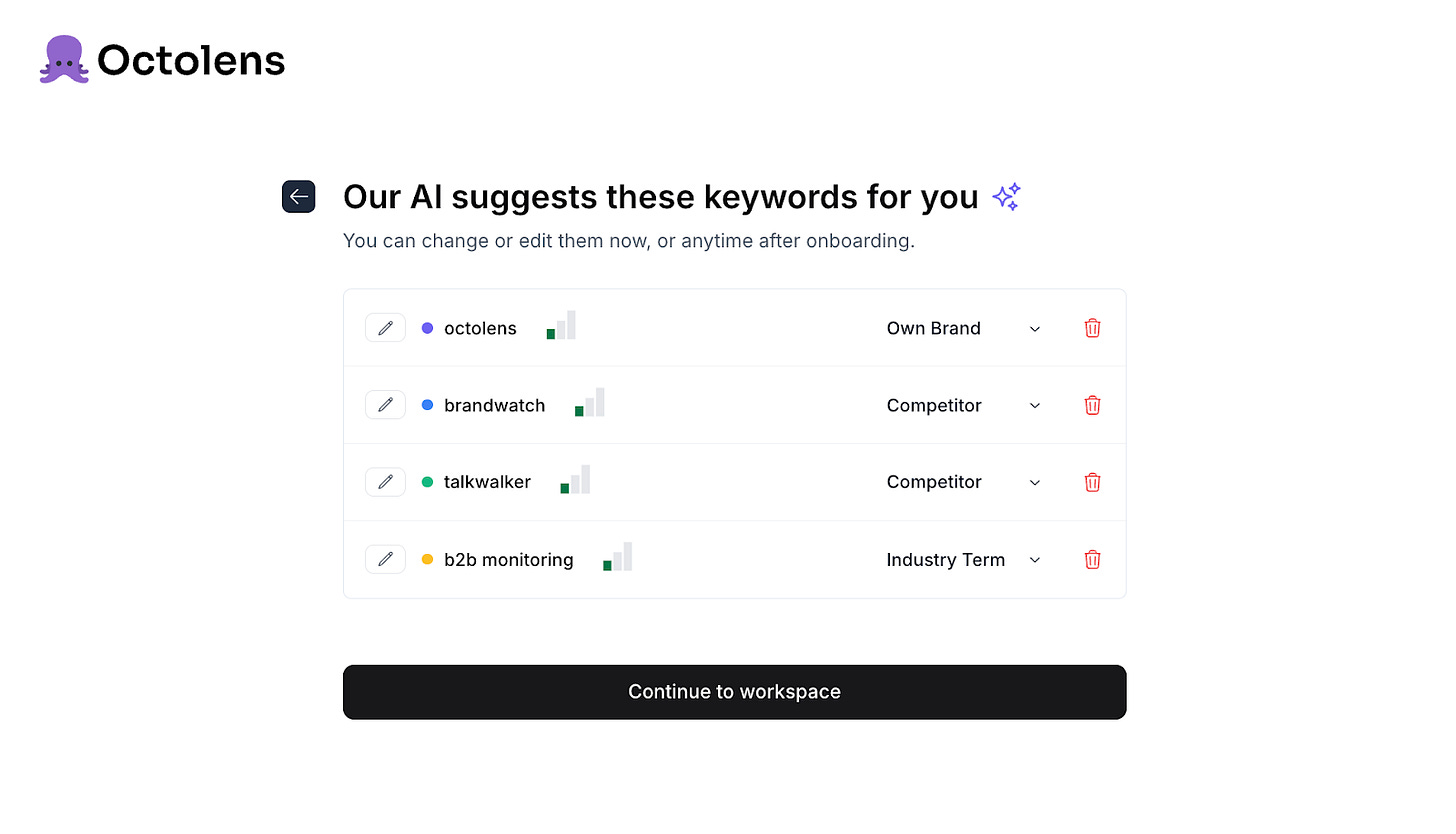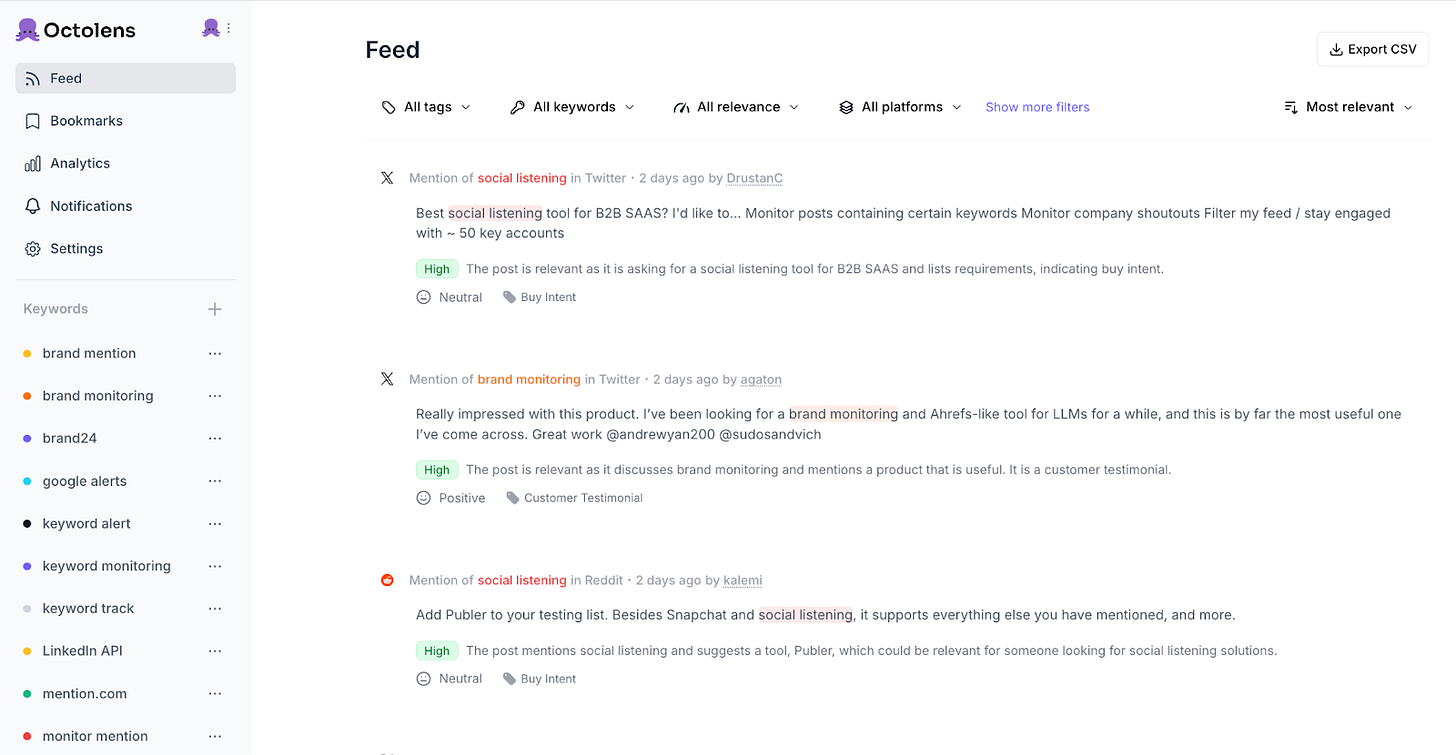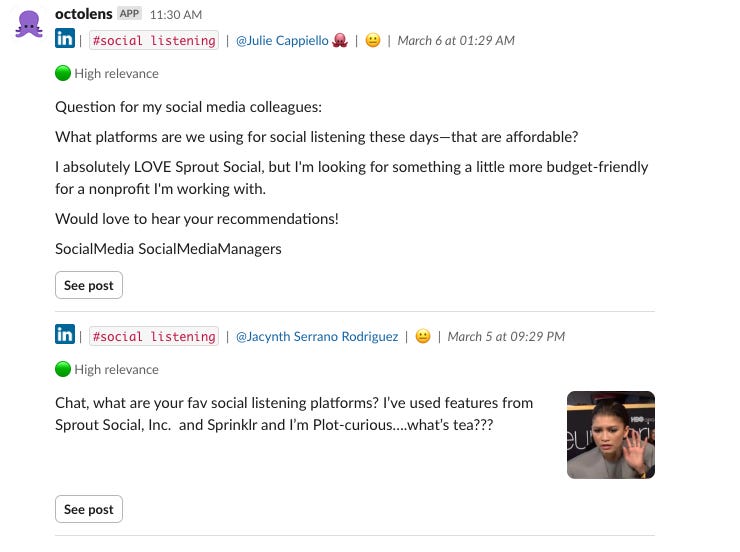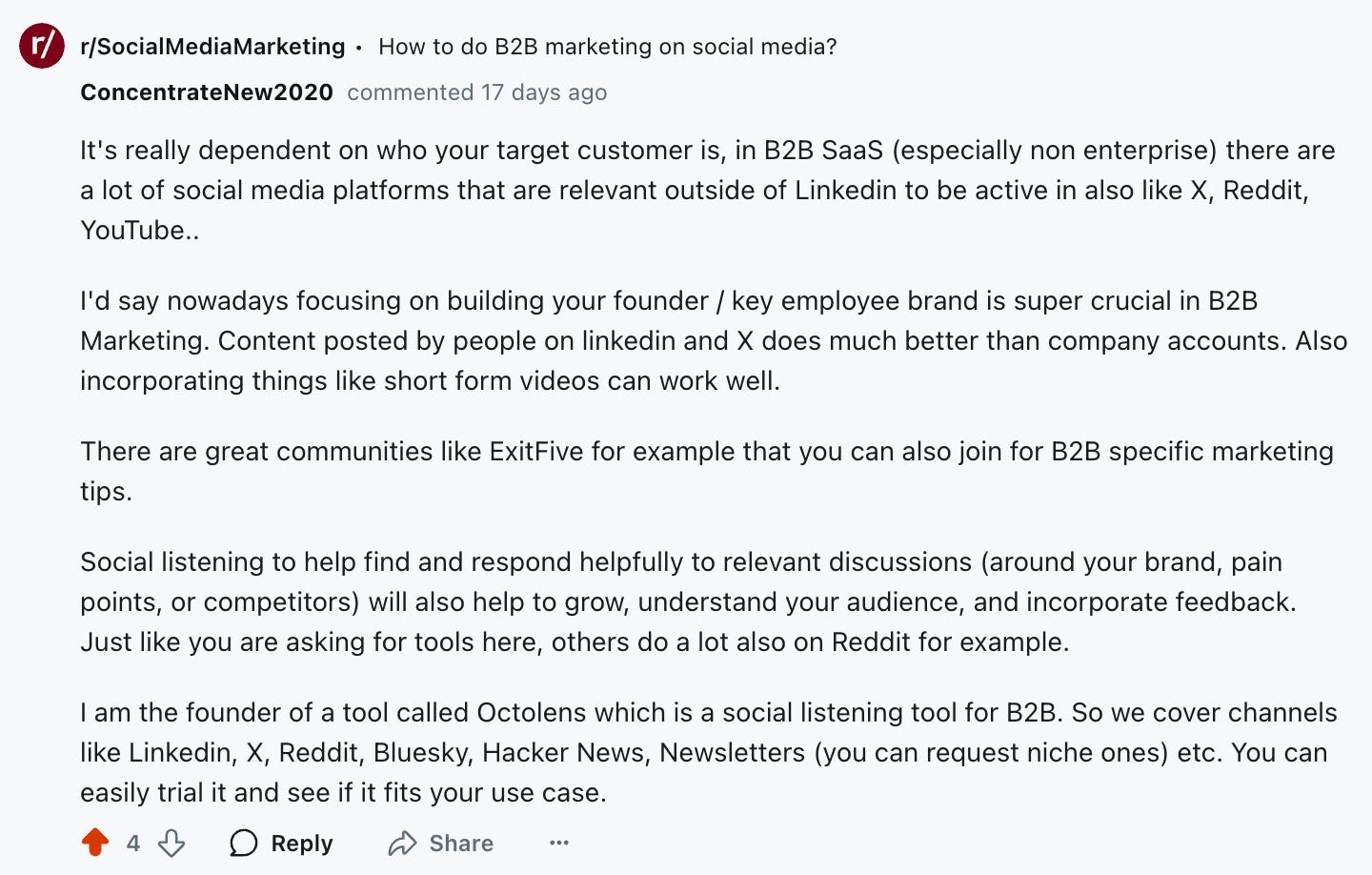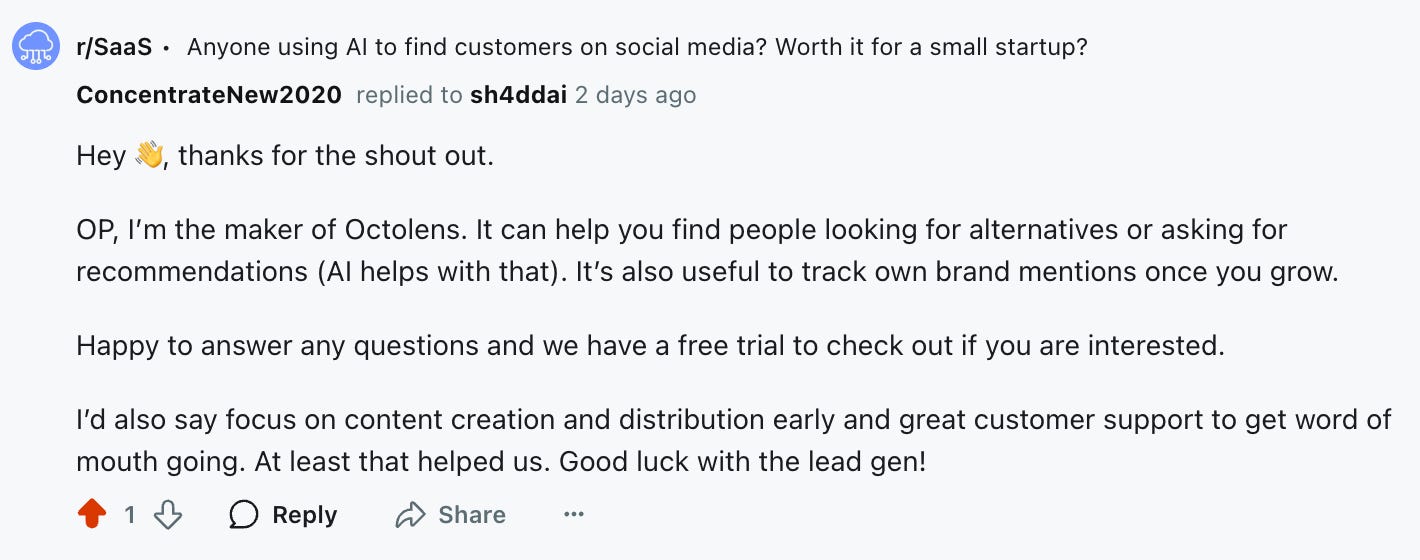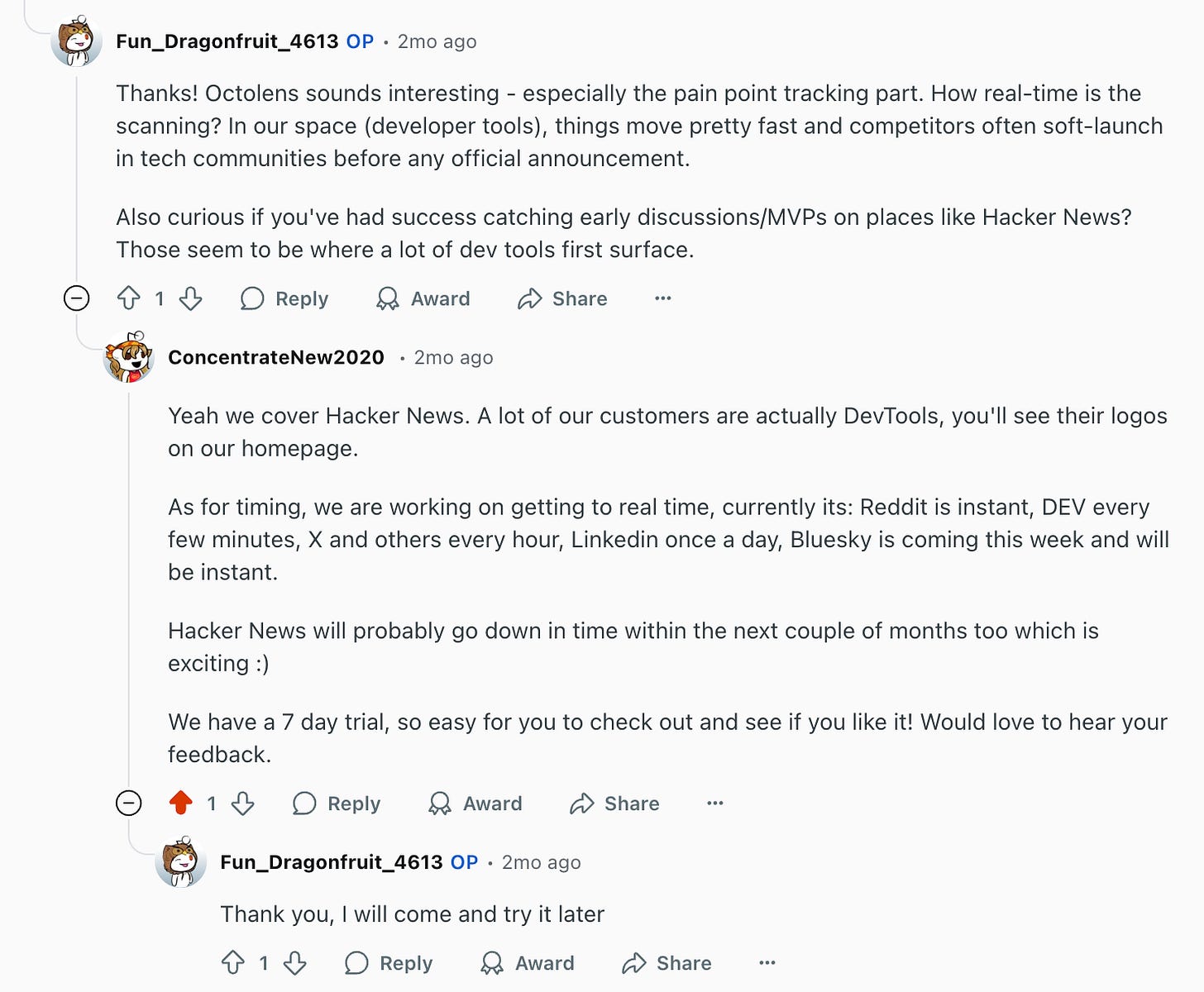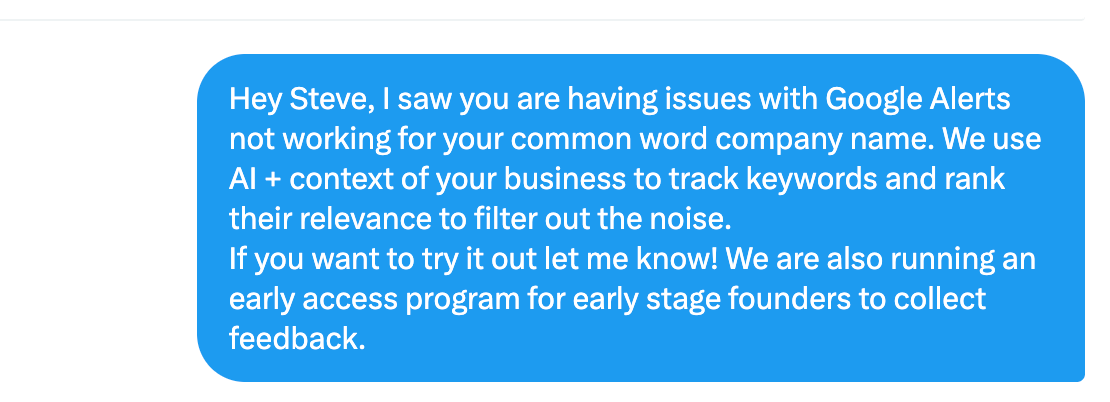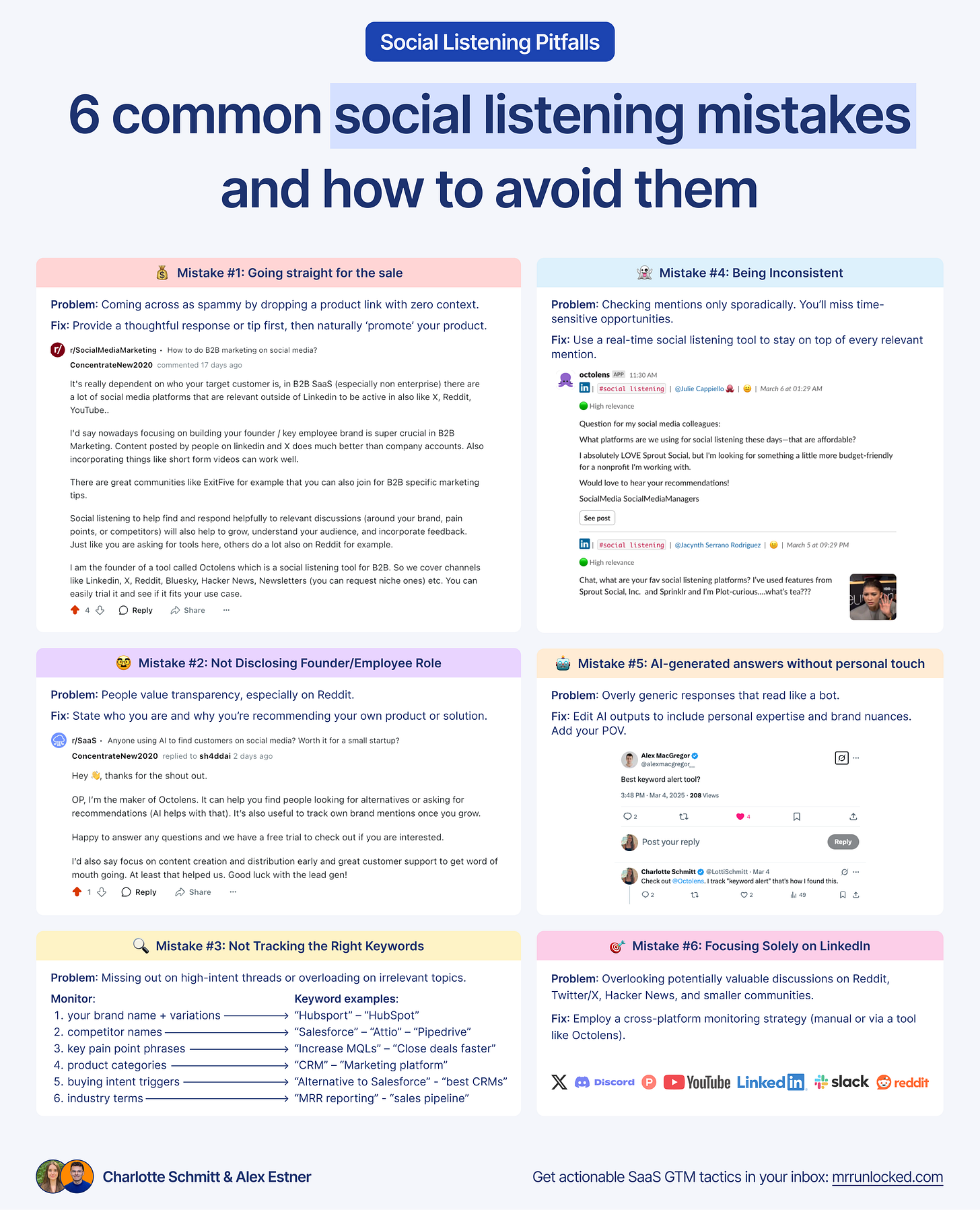Social Listening: Identifying High-Intent Mentions to Grow Your SaaS
Hey - it’s Alex - this time together with Charlotte Schmitt!
Today we cover:
1️⃣ How to monitor the right (high-intent) mentions
2️⃣ Real examples of B2B SaaS leveraging social listening
3️⃣ 6 Common Pitfalls & How to Avoid Them
Bonus: List of my vetted Go-to software tools for early-stage SaaS startups
In case you missed the last 3 episodes:
✅ 4 Allbound Playbook to Generate Pipeline in 2025
✅ The Ultimate Guide on Case Studies & Testimonials
✅ The LinkedIn Sales Navigator Guide
A quick word from our sponsors
📢 Ahrefs— Looking for a Google Analytics 4 alternative?
Ahrefs’ Web Analytics provides a simple and free solution to track and report website’s traffic. No cookies. No personal data collected. Just the metrics you need. It's also free.
📢 Turf— The #1 community platform for SaaS companies
Turf provides embeddable community forum software that drives customer engagement through in-depth discussions between your users. Build your fully branded community environment and embed it inside your SaaS product or website.
Want to reach 4500+ early-stage SaaS founders/leaders? Sponsor the next newsletter.
Social Listening for SaaS founders
Founders, especially early-stage ones, know that having as many potential user conversations as possible is key to success.
Social listening – tracking and engaging with relevant conversations online – can, therefore, be a great lever for growth.
From high-intent mentions (those signals that someone needs a solution like yours), founders can win new customers, inform product decisions, and build awareness without a big marketing budget.
Today, we will break down how to leverage social listening to grow your SaaS with best practices you can implement right now.
We will go over:
What is social listening
Real examples of B2B SaaS using Social Listening to grow
How to Monitor for High-Intent Mentions
How to engage successfully & leverage insights
1. What is Social Listening?
Social listening is the process of monitoring online conversations about your brand, product, and industry, usually via tracking certain keywords. You can then analyze those discussions for insights and act on opportunities.
In a B2B SaaS context, it means keeping an ear to the ground where your target users discuss (X (Twitter), LinkedIn, Reddit, Slack communities, etc.).
It’s about understanding pain points, spotting trends, and jumping in when someone signals a need you can fulfill.
For early-stage SaaS companies, social listening can be an efficient growth tool.
Why? Because in the 0-1M ARR stage,
❌ You likely don’t have a huge brand presence or a big budget for ads.
✅ You do, however, have the agility to personally engage with users and adapt quickly.
Social listening lets you:
1️⃣ Discover early leads – You can find people actively asking for the solution you offer or complaining about a competitor, and get on their radar organically.
2️⃣ Get unfiltered feedback – People are often brutally honest on social media and forums (cough cough Reddit). This feedback is gold for refining your product and messaging.
3️⃣ Build brand awareness – By participating in conversations, you start to be seen as part of the community, not just an ad in the sidebar. This builds trust and awareness step by step.
4️⃣ Inform strategy – Patterns in discussions can reveal what features users care about, what language they use, where they spend their time, and how they compare options, guiding your product roadmap and marketing strategy.
5️⃣ Collect testimonials - Organic mentions of your product are a great way to collect first testimonials (especially if you’re PLG). We wrote a full guide on how to collect case studies and testimonials in a previous episode.
Social Listening vs. Brand Monitoring
It’s easy to confuse social listening with brand monitoring – they are related:
Brand monitoring is tracking and responding to direct mentions of your brand or product. It’s like customer service on social media. For example, if someone tags your X handle to report a bug or ask a question, you respond. It’s crucial, especially for bigger brands that get mentioned a lot, but less so if you are just starting.
Social listening involves tracking broader conversations beyond those where you’re mentioned. It’s proactive – you’re looking at what people say about the problem you solve, the pain points in your industry, and discussions about competitors or related topics. The goal is to understand your audience and jump on opportunities.
Think of it this way: if someone tweets
“Any recommendations for an affordable form builder?”
An early-stage SaaS founder practicing social listening can catch that tweet (even though their product wasn’t mentioned) and see a potential customer asking for help.
2. Real examples of B2B SaaS using Social Listening to grow
Let’s look at how real companies have leveraged social listening to drive growth, improve their product, and find their first customers.
Finding users and shaping features with social listening
Tally, a popular bootstrapped form-building SaaS, is a great example of an early-stage company that used social listening to grow. Tally recently made waves for reaching 2M in ARR with just a team of 5 and completely bootstrapped.
Co-founder Marie Martens has said that social listening became one of the best marketing hacks she used. Instead of paid advertising, she spent time scanning online conversations about form builders on platforms like Twitter, Reddit, and Quora.
Whenever she spotted someone asking for a form tool recommendation or complaining about the limitations of Google Forms/Typeform, Marie would come in with a helpful answer.
Often, that included mentioning Tally as an option – but crucially, in a way that felt natural and not salesy.
Someone looks for a form-building tool that has this feature.
You can just say👇
“Hey, I’m building this, feel free to try it out.”
It works because it’s relevant. It’s not pushy, it doesn’t feel like you’re doing marketing – you’re just, as a founder, sharing your product.”
Importantly, Tally’s team didn’t just hunt for potential customers – they also listened for feedback and ideas. By reading these user questions and discussions, you see:
The pain points your audience struggles with
What people are searching for
What your own product currently lacks
What competitors are being mentioned, and how
Where your target audience hangs out
To streamline this process, the Tally team set up a dedicated Slack channel pumping in social mentions in real-time. These mentions were found by tracking keywords with a social listening tool like “form-builder”, “google forms”, “typefully”.
Tally’s story shows how early-stage founders can use social listening as a multiplier: every question answered was not just one potential signup but also content inspiration and feedback.
Finding Users Looking for Open-Source Alternatives to DocuSign
Documenso is an open-source alternative to well-known signing tools like DocuSign and DocSend founded by Timur Ercan.
One of their strategies for growth: monitor social media for conversations where people explicitly say they’re unhappy with DocuSign or other bigger incumbents e.g., “looking for a DocuSign alternative.”
Or those who are on the hunt for open-source offerings.
These are high-intent signals.
For example, the team kept an eye on:
X (Twitter) for people posting about high signing tool costs
Reddit threads in r/selfhosted and r/SaaS where users frequently asked about signing tools and open-source options
That way Documenso could make sure their name is in the mix. By jumping into those threads with helpful info, they managed to capture the attention of exactly the kind of user who would value their product.
The types of posts relevant to Documenso:
Documenso’s team also engaged with the broader open-source and dev communities on platforms like Hacker News, GitHub, Product Hunt, and dedicated Slack communities.
Creator of Dev Marketing Slack community, Flo Merian noted that being transparent and sharing progress publicly helped attract users for Documenso; whenever they saw threads about open-source software or digital signing solutions, they “got involved” in the conversation and linked back to their project on GitHub.
This not only drove traffic and stars to their repository (growing social proof), but also funneled interested developers into their user base.
The key lessons here:
1. if your startup is up against big competitors, tune into the conversations where the discontent or needs around those competitors are expressed.
2. Find out specifically where YOUR audience hangs out to join the conversation;, this will be different for DevTool audiences vs. something like HR or Design professionals.
Dogfooding Octolens to Acquire Customers
Octolens is the AI social listening tool that co-founder Charlotte Schmitt founded.
It tracks keywords across socials continuously and notifies you when high-value posts come up (e.g., posts with buy-intent or customer complaints).
Since its first days, Octolens has used Octolens to grow. Dogfooding your own SaaS comes with many benefits, and luckily, in our case, that includes customer acquisition.
The keywords we use to grow are a mix of competitors, industry terms, and our own brand.
Social listening is not a novel field, so there are several incumbents worth tracking. These include, for example:
“Google Alerts”, “Brand24”, “Mention”, and “Brandwatch”.
Here are a few of the posts in our Octolens feed for the keyword Google Alerts, all people complaining about the tool. All opportunities to plug Octolens as an alternative.
Tracking industry terms like “social listening”, “keyword tracking”, and “brand monitoring” also helps surface high buy-intent posts. For example:
Every morning, Charlotte goes through her daily roundup email to see if anything interesting has happened since ending work the day before.
On top of that, for any new mentions during the day, she gets slack notifications delivered so she can act fast.
3. How to Monitor for High-Intent Mentions
So, how do you do social listening in practice? It boils down to these 4 steps:
Identify key channels where your audience and industry peers are most active (e.g., LinkedIn, Twitter/X, Reddit, Hacker News).
Define the keywords you need to track—brand names, product names, competitor names, and specific pain points.
Monitoring your channels either with a social listening tool or manually to find relevant conversations based on the keywords.
Take action, for example, to respond quickly and thoughtfully to mentions that matter (both positive and negative) or learn from current sentiment to apply to your business (e.g., add a new feature).
Step 1: Identify key channels where to track conversations
Your potential customers hang out in more places than you might initially think. Here are some of the top platforms and channels to monitor for B2B SaaS-related conversations:
Twitter (X) – People often ask for tool recommendations or vent about products on Twitter. Search for keywords and hashtags related to your space (e.g. #emailmarketing or “CRM recommendation”). Many founders have found leads by replying to tweets like “Looking for a better solution than X, any ideas?”. Twitter’s advanced search lets you define things like exact match, AND/OR operators, and language.
LinkedIn – On LinkedIn, conversations are a bit more formal but very valuable for B2B. Monitor posts from your network or in relevant groups where people discuss vendors, tools, or industry pain points. A VP might post “We’re struggling with our onboarding process – what’s everyone using for user analytics?” That’s a huge opportunity if you have an analytics SaaS. Use LinkedIn search for recent posts and also watch comment sections on influencers’ posts – lots of insights and questions pop up there.
Reddit – there’s a subreddit for nearly every niche. Find the subreddits where your target users hang out. For example, r/SaaS, r/startups, or tech-specific ones like r/analytics, r/marketingautomation, r/selfhosted (for open-source alternatives) etc. People on Reddit frequently ask for product recommendations or help (“How do I do X?” or “Best alternative to Y?”). Use Reddit’s search or tools like F5bot to get alerts for keywords (F5bot will email you whenever your chosen keywords are mentioned on Reddit – super handy for a free tool).
Slack & Discord Communities – Many industries have private or semi-private communities on Slack or Discord servers where professionals exchange. For example, there might be a Slack group for UX designers or a Discord for indie hackers. Join the ones relevant to your audience. While you can’t automatically monitor these as easily (since they’re closed environments), being an active member and using the internal search is key. Once in, start by adding value in the community first and then keep an eye on new messages. Some Slack communities also have announcement channels where people ask for tool suggestions – watch those.
Forums & Q&A Sites – Don’t ignore places like Quora, Stack Overflow (for dev tools), or industry-specific forums. Quora has tons of questions like “What’s the best software for X?” which are literally someone asking for a solution. Niche forums (such as a community on GrowthHackers for marketing tech, or Spiceworks for IT software) can also have valuable chatter. If there’s a forum for your vertical, consider making it part of your routine.
Product Hunt / Hacker News – When someone is actively searching for new tools, they might browse Product Hunt or post on Hacker News (“Ask HN: Looking for a X solution that does Y”). Keep an eye on those “Ask HN” posts or discussions about competitors on HN. Product Hunt comments can also reveal early user impressions or needs. While these are more sporadic, they’re high intent when they happen.
Bluesky: A newer, decentralized social platform gaining momentum among early adopters and tech enthusiasts. Could be a hidden goldmine for forward-looking SaaS founders - a lot of people have been migrating from X to Bluesky, so you’ll want to cover both.
YouTube: With over two billion logged-in users each month, YouTube isn’t just for entertainment—it’s a massive hub for product demos, tutorials, and thought leadership content. B2B SaaS founders can showcase how their software works in real-world scenarios, while prospects often watch “how-to” videos and unbiased reviews before making buying decisions.
Depending on your niche, you may also want to focus on Facebook groups, TikTok, or Instagram, however, those tend to be more relevant for B2C companies.
In short, go wherever your target customers ask questions or share opinions online. Make a list of these platforms.
To start, pick the top 2-3 where you suspect the highest activity (commonly Twitter, Reddit, and one other, like LinkedIn or a forum). You can always expand later.
Step 2: Choose your relevant keywords
Once you know where to listen, the next step is deciding what to listen for and setting up a system to do it continuously. Here’s how to set up your keyword and brand monitoring:
Start with a list of terms to track. These typically include:
Your brand name - and your social handles, you won’t want to miss any posts that mention your brand directly. If your brand name is a common word, include some context (e.g. track “Notion.so” or “@notionHQ” instead of “Notion”) or some additional terms (e.g., a post needs to include “Juicebox” AND “AI”). You might even consider tracking some common misspellings, e.g. “Hubspot” vs “HubSpot”.
Your product’s category – think like a user who doesn’t know your brand. For example, Tally might track “form builder” or “online form tool”. Documenso tracks “e-signature tool” or “signing software”. Include variations and related terms. A tool like Attio or Pipedrive might search for “CRM tool” or “SaaS CRM”. Companies like Monday.com or Asana may track words like “project management software” and “work management platform”.
Competitor names – list your direct competitors and even adjacent solutions. If people mention them, you want to know (could be an opportunity if they’re unhappy or looking around).
Pain point phrases – things your target user might say when experiencing the problem your SaaS solves. E.g., if you have a server monitoring SaaS, track phrases like “server downtime alert” or “monitoring our servers”. Or “high SaaS CACs”, “high churn rate” or “slow sales cycle” if your product helps fix those pain points. These can lead you to discussions where your solution is relevant.
Buying intent triggers – words like “recommendation, alternative, vs, choosing, looking for, anyone use...” combined with category terms. For example, “recommend CRM” or “alternative to Salesforce”.
Industry terms - words that are used a lot by your ICP and allow you to start a meaningful discussion on social. Example: “MRR reporting” (for SaaS industry, e.g. if you’re a financial tool for SaaS companies) or ‘cart abandonment rate’ (for e-commerce)
Step 3: Start monitoring manually or set up monitoring tools
Once you have your platforms and keywords, it’s about consistently monitoring and jumping on opportunities.
The most basic way to do it is manually. It’s also the most time-consuming approach, but a good way to get into the habit and get started.
In this case, block a recurring time in your calendar and go through the platforms and keywords you have identified one by one. Prioritize answering high-intent mentions fast.
To help refine your searches, you can make use of advanced search settings where possible. e.g., Boolean operators – Search for “data drift” AND “AI” to filter only for posts that contain both keywords. This is available on most platforms.
Another example, “Vercel” and “AI” on twitter:
Check out these resources for using Boolean searches on LInkedin, advanced searches on X (Twitter), and Reddit.
The problem with manual tracking is that you’ll often miss timely mentions, and either the author has already gotten what they were looking for from someone else, or it's not a top priority anymore.
This is where social listening tools can be handy. There are a few you can consider as an early-stage SaaS:
Google Alerts (free) – Set up alerts for key terms to track mentions across blogs, news sites, and forums. While not real-time, it’s useful for catching broader industry discussions. It won’t get most social mentions though and has a lot of noise.
F5bot (free) – Get email alerts for mentions of your keywords on Reddit and Hacker News.
Octolens (paid) – Octolens (disclaimer, Charlotte, the co-author, is the founder) is built for B2B SaaS in mind and uses AI to help filter out the noise and bring to the forefront buy-intent and other high-value mentions on platforms like Twitter, Reddit, LinkedIn, forums, and more. Get email, slack, or webhook alerts for important mentions so you can react fast.
Brand24 or Mention (paid) – Another option is Brand24 or Mention, they are slightly more upmarket and also cover some more platforms relevant outside of B2B.
Brandwatch or Hootsuite (paid) – These are the really big ones that are more like social media marketing suites with analytics and scheduling as part of the offer. These are more relevant for enterprise customers and agencies.
A tool will do this for you, but even if you are tracking keywords manually, it’s important to keep track of high-value mentions somewhere. For example, in a Slack channel or a Google sheet.
That way, you can see patterns in what types of keywords people use in mentions with high buy intent or those where you can draw insights from. For example, if you are seeing negative feedback about competitors, you should respond, but you should also log that information to use it in the future.
You’ll also be able to refine what kind of keywords you are searching for in your daily routine to be able to refine.
Tracking mentions with Octolens
If you do have a bit of budget for a tool and want to cut out hours of manual repetitive work, here’s a quick overview of how Octolens helps you find high-intent mentions on autopilot:
1. Sign up for a free trial.
2. Complete onboarding by adding your URL, Octolens uses AI to research your company and suggests keywords (a mix of brand name, competitors, and industry terms) which you can edit or add to later.
3. Your feed will populate with AI-ranked posts (high-buy intent will always be marked as high), and from now on will update with new ones coming up across all B2B SaaS relevant platforms like X, LinkedIn, Reddit, Bluesky, Hacker News, and co.
4. Set up notifications where you like to receive them: Email, Slack, or via Webhooks
E.g., Octolens Slack notifications for high-relevance mentions.
5. Engage and grow!
When you get an alert for a high-relevance mention, react fast!
Regardless of whether it's manual or with a tool like Octolens, the next section will show you how you engage effectively with high-intent mentions to grow.
Step 4: Engaging with High-Intent Mentions
Once you identify high-intent discussions, the next step is to engage effectively to try and win customers or nurture the lead. Here’s how to do it without sounding spammy.
1. Provide Value First
Instead of immediately pitching your product, contribute meaningfully to the conversation.
→ Check out how to do ‘value comments’ on LinkedIn
2. Be Transparent About Who You Are
If you’re the founder, say so—it builds credibility.
3. Follow Up When Needed
If someone shows interest, follow up in a helpful way or address any problems/questions that come up. You can also offer an extended free trial, share use cases, or invite them to a private chat or call.
4. Know When to Take It to DMs
Some discussions, especially on Reddit or LinkedIn, are better moved to private messages. A good approach: “Happy to share more details—DM me if you’d like a walkthrough.”
Or if you’d like to reshare content, whether it's positive endorsements or complaints about competitors, follow up with a DM to ask for permission. Distributing UGC or relevant content is a valuable perk of social listening.
Leveraging Insights from Social Listening
Beyond direct customer acquisition, social listening can also help you with the following:
Turn Insights into Content
If many people talk about specific things over and over again on social, you can create dedicated content (e.g. LinkedIn posts or Blog posts) for this topic.
Improve Product Messaging and Positioning
Adopt user language – If people call your category “workflow automation” instead of “task management,” use their wording in your marketing.
Highlight the right pain points – If competitors’ pricing keeps coming up as a frustration, emphasize affordability in your messaging.
Address objections upfront – If users think your tool lacks integrations, proactively clarify what’s available.
Optimize Your Product Based on User Needs
Track feature requests and prioritize development based on what users ask for.
Identify and fix common UX frustrations users mention in public conversations (including what they don’t love about the competition).
Engage power users by inviting them to beta test new features.
6 Common Pitfalls & How to Avoid Them
Charlotte and the Octolens team have seen them all.
Over +1,000 founders and GTM team members using Octolens, so she learned a lot about what not to do.
Here are 6 common social listening mistakes founders and GTM teams make and how to avoid them.
❌ Mistake #1: Going Straight for the Sale
Problem: Coming across as spammy by dropping a product link with zero context.
Fix: Provide a thoughtful response or tip first, then naturally ‘promote’ your product.
❌ Mistake #2: Not Disclosing Founder/Employee Role
Problem: People value transparency, especially on Reddit.
Fix: State who you are and why you’re recommending your own product or solution.
❌ Mistake #3: Not Tracking the Right Keywords
Problem: Missing out on high-intent threads or overloading on irrelevant topics.
Fix: Monitor competitor names, key pain points, product categories & multiple variations of your brand name.
❌ Mistake #4: Using AI-Generated Answers Without a Personal Touch
Problem: Overly generic responses that read like a bot.
Fix: Edit AI outputs to include personal expertise and brand nuances. Add your POV.
❌ Mistake #5: Focusing Solely on LinkedIn
Problem: Overlooking potentially valuable discussions on Reddit, Twitter/X, Hacker News, and smaller communities.
Fix: Employ a cross-platform monitoring strategy (manual or via a tool like Octolens).
❌ Mistake #6: Being Inconsistent
Problem: Checking mentions only sporadically. You’ll miss time-sensitive opportunities.
Fix: Use a real-time social listening tool to keep up with every relevant mention.
Final Takeaway
Social listening is an underutilized growth tactic for early-stage SaaS founders.
You create a compounding effect that drives both customer acquisition and product-market fit by tracking high-intent mentions, engaging authentically, and using insights to refine your product and messaging.
Happy growth 🚀
3 ways I can help you grow your SaaS to €1 million ARR 👇
1️⃣ Build your SaaS GTM strategy with my free Workbook (helped 5000+ SaaS leaders)
2️⃣ Get access to 100+ actionable SaaS growth tactics (helped 250+ SaaS leaders)
3️⃣ Work 1-on-1 with me - GTM Advisory for SaaS founders from 0€ to €1 million ARR






